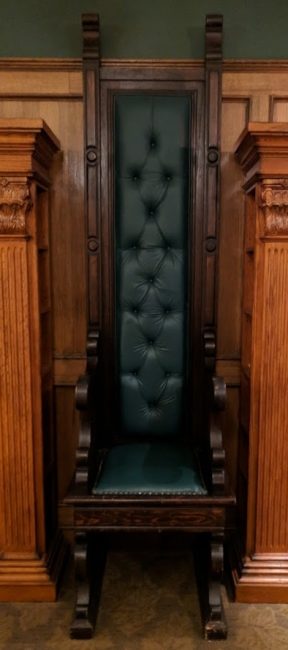When does chair discuss and vote?

This chair, seen at the Fairhaven Village Inn in Bellingham, Washington, was a prop for the movie “The King and I.” It embodies the authority of the chair of the meeting.
Confusion about the role of the chair at meetings can be widespread. Here are some parameters.
Chair of large meeting does not discuss and vote
When a large assembly (group) is meeting, the chair serves as a facilitator. The chair does not take part in debate (discussion) and does not vote, unless the vote is by ballot. This is a basic and important rule for large groups.
If for some reason the chair feels impelled to speak in discussion, the chair steps down from the chair (position of authority) and another person takes over. Customarily this is the vice-chair or vice-president, if that person has not yet spoken in discussion. The chair remains seated with the ordinary members until the matter is decided, after which the chair steps up again.
When I was president of the Northwest Translators and Interpreters Society, we were discussing a code of conduct provision that would have prevented our members from criticizing each other. I believed strongly that this was improper, so I handed over the gavel to the vice-president and expressed my views along with the other members (who voted in accord with my position, I’m happy to say!). I was fortunate in having a capable vice-president who was not fazed by this challenge.
Chair of small board may discuss and vote
Robert’s Rules of Order has special rules for small boards (read about them here). A “small board” is defined as up to about 12 people.
In a small board, the chair may make motions, may take part in debate, and may vote, unless the law, regulations or bylaws of your organization say otherwise.
While Robert’s allows this freedom to the chair, Jurassic Parliament believes that in general the chair should refrain from making motions. The chair can invite the members this way: “Does any member care to make a motion that…?”
If the chair wishes to discuss, they should speak last. And if they vote, they should vote last. The reason is that we humans tend to give undue deference to our leader. Better decisions arise when everyone is on an equal footing, and the chair can encourage this by holding back a bit. Please note that these are Jurassic Parliament suggestions, and are not included in Robert’s Rules of Order.
Law and regulation affect when chair may discuss and vote
In looking at your own situation, be sure to examine any state laws or regulations that apply to your situation. These have higher authority than Robert’s Rules of Order.
Example: In Washington state, under the “mayor/council” form of government, it is often customary for an elected mayor to take some part in the debate, though the mayor must not dominate the discussion. An elected mayor does not vote except in certain specific instances, which you can read about in the Citizen’s Guide here.
Example: Another form of government in Washington State is the “council/manager” system. Under this form, the council is elected by the citizens, and the council then elects the mayor. The Revised Code of Washington states that the mayor in this form has full rights to participate and debate (see RCW 35A.12.110). We believe that this is right and just, since a councilmember serving as mayor would fail to represent their constituency if they refrained from debating and voting. If you are serving on an elected local government body, we believe that you should debate and vote, unless the rules or bylaws say otherwise.
Bylaws can affect when chair may discuss and vote
Sometimes bylaws say that the chair does not vote “except in case of a tie.” The actual language in Robert’s Rules of Order Newly Revised, 12th edition is a little different:
“The chair protects his impartial position by exercising his voting right only when his vote would affect the outcome, in which case he can either vote and thereby change the result, or he can abstain.” Section 4:56.
These little words, “affect the outcome,” lead to the following guidance:
- If there is a tie vote—equal votes in favor and against—the chair can vote in favor to break the tie.
- However, if there is one more vote in favor than against, the chair can also vote against, thereby creating a tie. Since a tie vote fails, this means that the motion is lost.
If your bylaws say “the chair does not vote except in case of a tie,” we recommend amending them to use Robert’s language. Note that the chair gets only one vote.
Always remember, Robert’s Rules of Order is the foundation on which you build your house, using the laws, regulations and bylaws that apply to your specific situation. Read your bylaws! They are crucial to guide your organization. And create “special rules of order” as needed. You can read about them here.
Have you had issues around the role of the chair? Comment below or contact us here and let us know!

